Center-Rear Position Seat Belt
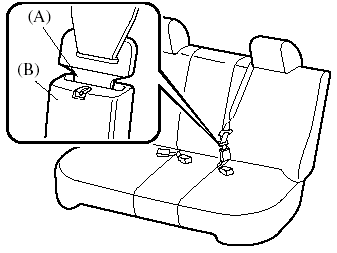
Before using the center-rear lap/shoulder belt make sure tongue (A) and anchor buckle (B) are fastened.
Fastening the Seat Belt
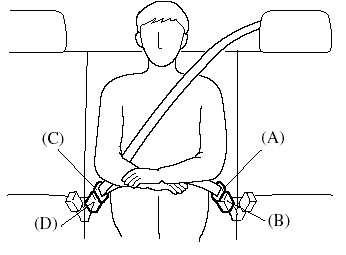
1. Grasp the tongue (C).
2. Slowly pull out the lap/shoulder belt.
3. Insert the tongue (C) into the buckle (D) until you hear a click.
WARNING:
Fastening the Center-Rear Seat Belt
with Only One Buckle:
Fastening the center-rear seat belt
with only one buckle is dangerous. If
only one pair of seat belt tongue and
buckle, either tongue (A) and anchor
buckle (B) or tongue (C) and anchor
buckle (D), is fastened, the seat belt
cannot provide full protection. In a
sudden stop or collision, the user
could slide under the belt and suffer
serious injuries. Always make sure
that both pairs of seat belt tongues
and buckles are fastened properly.
Positioning the Shoulder Portion of the
Seat Belt:
Improper positioning of the shoulder
portion of the seat belt is dangerous.
Always make sure the shoulder portion of the seat belt is positioned across your shoulder and near your neck, but never under your arm, on your neck, or on your upper arm.
4. Position the lap belt as low as possible, not on the abdominal area, then adjust the shoulder belt so that it fits snugly against your body.
WARNING:
Positioning the Lap Portion of the Seat
Belt:
The lap portion of the seat belt worn
too high is dangerous. In a collision,
this would concentrate the impact
force directly on the abdominal area,
causing serious injury. Wear the lap
portion of the belt snugly and as low
as possible.
Unfastening the Seat Belt
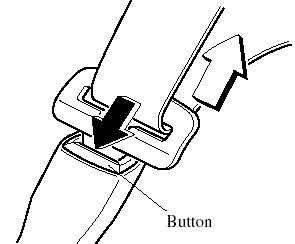
Depress the button on the buckle. If the belt does not fully retract, pull it out and check for kinks or twists. Then make sure it remains untwisted as it retracts.
NOTE:
If a belt does not fully retract, inspect it for
kinks and twists. If it is still not retracting
properly, have it inspected at an Authorized
Mazda Dealer.
Unfastening the Lap Portion of the Seat Belt
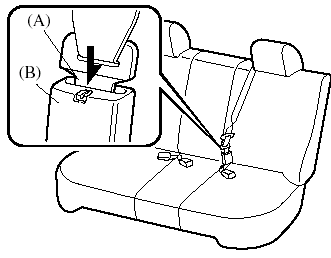
Insert a small object such as a key in the anchor buckle (B) slot.
CAUTION:
Always unfasten the lap portion of
the belt before folding the left-rear
seatback. Leaving the lap portion of
the belt fastened could cause
damage to the seat belt, buckle and
seatback.
NOTE:
To encourage rear seat passengers to wear
their seat belts, we suggest leaving the centerrear
lap position of the belt fastened at all
times except when folding the rear seat
forward.
Fastening the Lap Portion of the Seat Belt
Grasp tongue (A) and insert it into the anchor buckle (B) until you hear a click. It is now secure for passenger use.
NOTE:
After returning the left-rear seatback to its
upright position, fasten the lap portion of the
belt.
Stowing and pulling out the Center-Rear Position Seat Belt
The center-rear position seat belt can be stowed using the following procedure.
CAUTION:
When stowing the seat belt, make
sure the belt is locked securely into
the recess. If the seat belt is not
properly stowed, it might get caught
in the seats and be damaged.
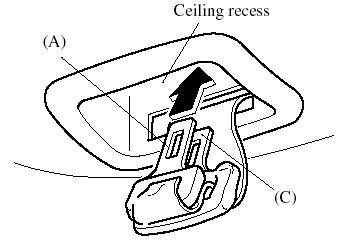
To stow the seat belt, retract the belt, put tongues (A) and (C) together and insert them into the recess.
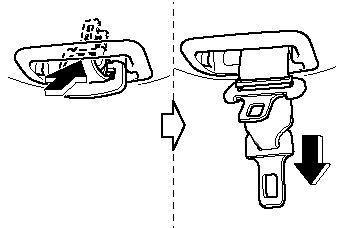
To pull out the seat belt, slide tongue (A) with your finger while moving it downward, and slowly pull out the seat belt from the ceiling recess.
NOTE:
Pulling out the seat belt all the way out will
switch it to automatic locking mode. If
automatic locking mode is not needed, retract
the seat belt fully to convert it back to
emergency locking mode.
See also:
Owner Maintenance Schedule
The owner or a qualified service technician should make these vehicle
inspections at the
indicated intervals to ensure safe and dependable operation.
Bring any problem to the attention of an Autho ...
Immobilizer System (with Advanced Key)
The immobilizer system allows the engine
to start only with an advanced key the
system recognizes.
If someone attempts to start the engine
with an unrecognized advanced key, the
engine will not s ...
Storage Compartments
WARNING:
Keep storage boxes closed when
driving:
Driving with the storage boxes open
is dangerous. To reduce the
possibility of injury in an accident or
a sudden stop, keep the storage
boxes cl ...


